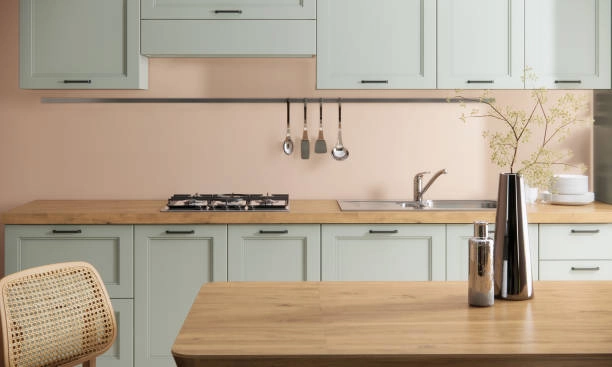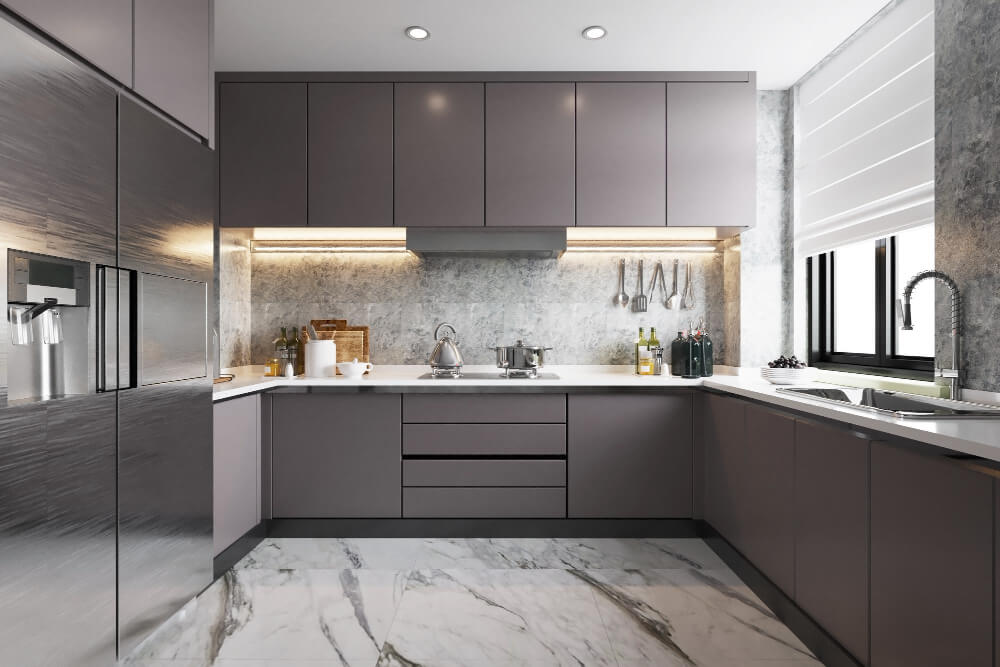Finish carpentry is a unique and skilled field within the carpentry world. It’s what turns the structural shell of a house into a refined, comfortable home. Unlike rough carpentry, which focuses on framing and building the skeletal structure, finish carpentry emphasizes detail, aesthetics, and precision. From moldings and baseboards to intricate staircases and wainscoting, this type of carpentry requires not only a keen eye but also the right set of finish carpentry tools. Whether you’re a seasoned professional or a budding carpenter, understanding the essential tools for finishing carpentry is key to achieving high-quality results. Here’s a guide to the must-have tools every carpenter should own.
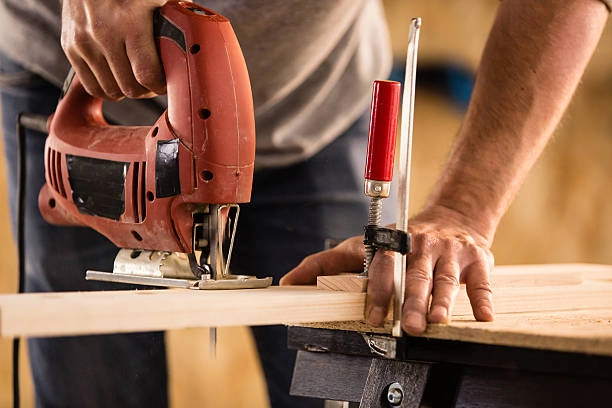
The Essential Finish Carpentry Tools
1. Measuring and Marking Tools
Precision is the cornerstone of finish carpentry. Even the smallest miscalculation can lead to noticeable imperfections. Therefore, having high-quality measuring and marking tools is non-negotiable.
- Tape Measure: A reliable tape measure is an essential tool. Opt for one that is sturdy, retractable, and marked in both metric and imperial units for maximum flexibility.
- Combination Square: This tool ensures perfect 90-degree and 45-degree angles, making it invaluable for tasks like cutting trim and moldings.
- Marking Gauge: For scribing parallel lines on a surface, a marking gauge helps keep markings consistent.
- Laser Level: In modern finish carpentry, a laser level can save time and improve accuracy when aligning long runs of trim or paneling.
2. Cutting Tools
Precise cutting is essential when working on trim carpentry and other detailed finish tasks. To achieve a professional look, your workpieces need to have clean, sharp edges. Using high-quality finish carpentry tools ensures that every cut meets the exact specifications, making a significant difference in the overall outcome of your project.
- Miter Saw: A miter saw is indispensable for cutting angles and achieving precise mitered edges for moldings and trim. A dual-bevel miter saw is even better, as it allows for cuts in both directions without flipping the material.
- Circular Saw: While often associated with rough carpentry, a high-quality circular saw with a fine-tooth blade can be used for making precise, straight cuts in finish carpentry.
- Jigsaw: This versatile tool is perfect for cutting curved or irregular shapes, which is often necessary for custom finish carpentry work.
- Coping Saw: Essential for trim carpentry tools, a coping saw is used to create intricate cuts and cope inside corners for seamless joints.
3. Hand Tools
Despite the influx of power tools, some traditional tools remain invaluable. These hand tools offer a level of control and finesse that power tools can’t always match, making them essential for achieving the finest details in your projects.
- Chisels: A set of sharp chisels is essential for tasks like mortising and cleaning out joints. They come in various sizes and are perfect for detail work.
- Block Plane: This tool is used for planning end grain, fitting trim, or easing edges. A sharp, adjustable block plane can help achieve perfectly smooth finishes.
- Hammer: For light taps and finishing nails, a hammer is still a must. A claw hammer with a smooth face is preferred to prevent marring the surface.
- Nail Set: This simple tool helps countersink nails without damaging the surface of the wood.
4. Power Tools for Precision
While hand tools bring finesse, power tools add speed and consistency, allowing carpenters to complete tasks more efficiently. A well-rounded set of finish carpentry tools that includes both hand and power options ensures the best of both worlds: precision and productivity.
- Nail Gun: A finish nailer or brad nailer is essential for trim and molding work. It drives nails quickly and accurately, ensuring a secure hold while reducing the risk of splitting the wood.
- Random Orbital Sander: Smooth finishes are vital in finish carpentry, and a random orbital sander makes sanding quick and effective. It’s perfect for smoothing large surfaces and eliminating minor imperfections.
- Router: A router is used for adding decorative edges, cutting grooves, or making custom moldings. It’s a versatile tool that adds a personal touch to carpentry projects.
- Multi-Tool: For cutting, sanding, and scraping in hard-to-reach places, an oscillating multi-tool is incredibly handy. It’s ideal for precision work like trimming baseboards or cutting out sections of drywall.
5. Clamps and Support Tools
Working with long or intricate pieces of wood requires a set of strong, reliable clamps and support systems. These finish carpentry tools are essential for maintaining stability and precision during your projects.
- Bar Clamps and C-Clamps: These keep pieces of wood in place as you work, ensuring accuracy in assembly and gluing.
- Workbench or Workstation: A sturdy, well-built workbench provides a flat surface and stability for cutting, sanding, and assembling pieces.
- Sawhorses: These portable stands are useful for supporting long pieces of trim or wood when cutting or sanding.
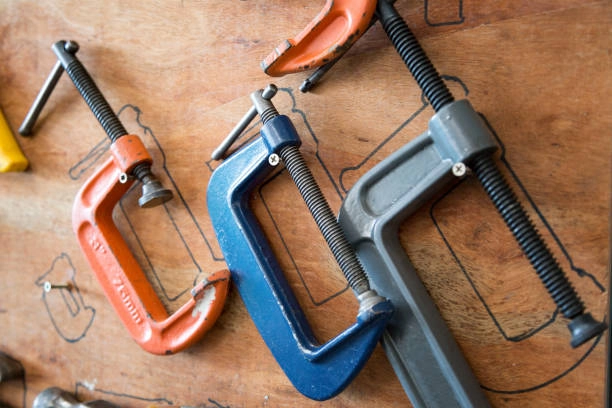
6. Finishing Tools
To achieve that final polished look, specialized finish carpentry tools are essential for sanding, smoothing, and applying protective finishes. These tools help bring out the quality and detail needed for a professional-grade result.
- Detail Sander: This is perfect for getting into tight spots and corners that a standard sander can’t reach.
- Caulking Gun: For filling gaps and ensuring a seamless look between trim and walls, a caulking gun is essential. It’s especially helpful in interior finish carpentry for achieving professional results.
- Putty Knife: Used to apply wood filler or putty for filling holes and imperfections, a flexible putty knife ensures smooth application.
7. Safety Equipment
Finish carpentry, like all forms of woodworking, requires attention to safety. Protective gear is crucial to prevent injury and long-term damage to your health. At Hollywood Refinishing, we prioritize using the right safety equipment to ensure that all carpentry work is performed safely and effectively.
- Safety Glasses: Protects eyes from wood particles, dust, and any flying debris during cutting or sanding.
- Hearing Protection: Power tools are noisy, and prolonged exposure can lead to hearing loss. Earplugs or earmuffs can help mitigate this risk.
- Dust Mask or Respirator: Fine wood dust is not only a nuisance but also a health hazard. A dust mask or respirator can protect your lungs from prolonged exposure.
8. Storage Solutions
Keeping finish carpentry tools organized and in good condition ensures they’re ready for use when needed. Carpenters should invest in:
- Toolbox or Tool Chest: A sturdy toolbox or a rolling tool chest can keep your tools organized and protected from damage.
- Storage Bins for Smaller Items: Keep screws, nails, and fasteners sorted in labeled bins for easy access.
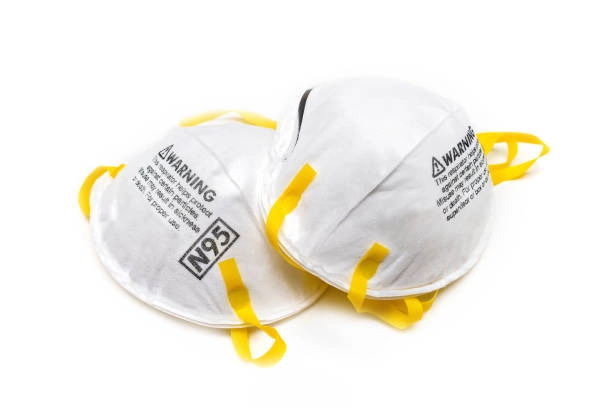
In conclusion, whether you’re a finish carpentry contractor working on custom projects or a carpenter focused on interior finish carpentry, having the right set of finish carpentry tools makes all the difference. The tools listed here form the backbone of a finished carpenter’s arsenal and can mean the difference between a job that looks homemade and one that looks professional. If you’re looking to start or expand your toolkit, consider these essentials for achieving superior results.
Finish carpentry transforms a simple house into a beautifully crafted home. It takes a combination of skill, patience, and the right tools to achieve the level of detail that clients expect. At Hollywood Refinishing, we pride ourselves on using these top-tier tools to deliver impeccable results. Contact us today to see how we can bring your remodeling project to life!
Frequently Asked Questions
1. What is finish carpentry and how does it differ from rough carpentry?
Finish carpentry involves the detailed work that completes a home’s interior, such as installing moldings, baseboards, staircases, and wainscoting. Unlike rough carpentry, which focuses on the basic structural framework, finish carpentry emphasizes precision and aesthetics to give a home its completed look.
2. What are the essential tools needed to finish carpentry?
Essential tools for finishing carpentry include measuring and marking tools like tape measures and combination squares, cutting tools such as miter saws and jigsaws, and hand tools like chisels and block planes. Power tools such as nail guns and routers, as well as sanding tools, are also important for achieving detailed and clean results.
3. Why is accuracy so important in interior finish carpentry?
Precision is crucial in interior finish carpentry because even small errors can be highly noticeable. Proper measuring and marking tools, along with quality finish carpentry tools for cutting and finishing, help ensure that each piece fits perfectly, creating a polished and professional appearance.
4. What tools should finish carpentry contractors prioritize for efficiency?
Finish carpentry contractors should prioritize tools that enhance both accuracy and speed. Key items include a reliable miter saw, a nail gun for quick fastening, and a random orbital sander for smoothing surfaces. Having both power and hand tools ensures flexibility for various tasks.
5. What safety equipment should be used in finish carpentry?
Safety equipment is essential to protect against potential hazards. Carpenters should use safety glasses to shield their eyes from dust and debris, hearing protection to prevent damage from loud power tools, and a dust mask or respirator to guard against fine wood particles.
6. What are some key differences between rough and finished carpentry?
Rough carpentry focuses on the structural aspects of building, such as framing walls and constructing support structures. It requires durability and strength. Finish carpentry, on the other hand, is about the finer details that add beauty and functionality to a home, ensuring a refined final look.
7. What tools can help achieve custom finish carpentry projects?
For custom finish carpentry projects, tools that offer precision and versatility are vital. A router can create custom moldings and decorative edges, while a coping saw is ideal for detailed trim work. Laser levels and multi-tools are also useful for aligning and cutting in complex areas.



